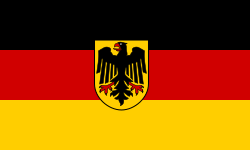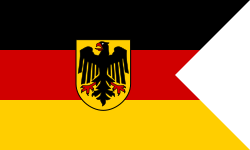Flag of Germany
It has been suggested that Flag of Nazi Germany and Talk:Flag of Germany#Merge proposal be merged into this article. (Discuss) Proposed since July 2007. |
 |
 |
 |
| Flags of Germany across time |
|---|
 Holy Roman Empire (800–1200) |
 Holy Roman Empire (1200-1350) |
 Holy Roman Empire (1350–1400) |
 Holy Roman Empire (1400–1806) |
 Confederation of the Rhine (1806-1813) |
 German Confederation (1848–66)[1] |
 North German Federation (1867–71) |
 German Empire (1871–1918) |
 Weimar Republic (1919–33) |
 Weimar Republic (co-official, used in foreign service, 1921–34) |
 Third Reich (1933–35) (The 3:5 variant of the Imperial German flag used from 1933 to 1935, then forbidden by the Nazis as "reactionary") |
 Third Reich 1933–45 (Political flag used jointly with previous flag 1933–35), then used on its own) |
 Flag of West Germany (1949–90) Flag of East Germany (1949–59) |
 Flag of the German Democratic Republic (1959–90; forbidden in the Federal Republic of Germany until 1969) |
 (Flag of Germany today) |
The flag of Germany was adopted in its present form in 1919. It was readopted with the new constitution of 1949. It is a tricolour, made of three equal horizontal bands coloured black (top), red, and gold (bottom).
Origins
The black and gold combination comes from the colours on the semi-official coat of arms of the Holy Roman Empire. These two colours later found their way into the flag of the Austrian Empire, created in 1804 by the last ruler of the Holy Roman Empire, Francis II. Austria's Habsburg Dynasty also used the colours and was appropriately known as the "Black and Gold monarchy."
In the radical 1840s, a black-red-gold flag was used to symbolize the movement against the conservative order, in favor of liberal republicanism. Since the Congress of Vienna in 1815, the monarchs managed to keep both Enlightenment liberalism and nationalism at bay, but this changed when harsh economic conditions struck in the 1840s. During the Springtime of the Peoples during the Revolutions of 1848, liberals took power and after prolonged deliberation, a National Assembly was finally formulated. This Frankfurt Parliament declared the black-red-gold as the official colours of Germany, with the red in the tricolour most likely a referencing the Hanseatic League and the gold and black used for its earlier references to the German people included in the "Black and Gold monarchy."
It has also been proposed that the colours red, black and gold were those of the Jena Student's League, one of the radically-minded Burschenschaften banned by Metternich in the Carlsbad Decrees. The Carlsbad Decrees set restrictions within the German Confederation, following the Congress of Vienna.
Another claim goes back to the uniforms — they were mainly black with red facings and gold buttons — of the Lützow Free Corps, comprised mostly of university students, and formed during the struggle against the occupying forces of Napoleon. It is also during the mid-nineteenth century that red became synonymous with revolution and Karl Marx's socialist vision, while the Communist Manifesto was published in 1848. Whatever the true explanation, black, red and gold were regarded as the colors of the liberal and republican movement of the Germans during this brief period, and especially after the color combination was reintroduced during the Weimar period, it become synonymous with German liberalism in general.
Ultimately, the Revolutions of 1848 failed and the monarchs returned to power. Partisan support had declined rapidly once economic conditions improved and the factory doors reopened. At the same time, conflicting views and interests prevented the liberal national experiment from taking off, and its representatives were unable to progress fast enough and secure power. The most pressing issue for the German radicals was whether or not to include Austria in this new German nation, as Austria's status as a multiethnic empire complicated the dream of a united Greater Germany — the grossdeutsch solution. Alternatively, there was the kleindeutsch solution for a Germany that did not encompass all German lands, and this avoided the multiethnic problem and perhaps just as importantly, issues of power distribution.
When a compromised German state later emerged, it would be for both of these reasons. An important step towards this kleindeutsch solution was the Austro-Prussian War in 1866. With that, the German Confederation was officially disbanded and Prussia went on to form its unofficial successor, the North German Federation, in 1867. On 25 June of that year, the coalition adopted a flag that blended the colours of its largest and smallest member Prussia (black and white) and the Hanseatic League (red and white) into a new black-white-red (schwarz-weiß-rot) horizontal tricolour. This flag would also be the national flag for the subsequent German Empire from 1892 to 1918.
Following Germany's defeat in World War I this Imperial flag fell into disuse and the new Weimar Republic officially reinstated the black-red-gold sequence on 11 August 1919. Throughout the days of the Weimar Republic there was a debate on which flag to use, causing strong controversy, with monarchists and conservatives in favor of re-adopting the black-white-red flag. In 1926 the old black-white-red flag was once more admitted to use, but only for Germany's diplomatic missions overseas.
Simultaneously, the symbols of Imperial Germany became symbols of conservative protestation and were often used by nationalists in demonstrations. This included the Reichskriegflagge, which has been revived in the present for similar use. When the Nazis came to power in 1933, the black-red-gold flag was removed and replaced with the black-white-red. However, after 15 September 1935, the Nazis replace virtually all German governmental flags with designs based featuring the swastika, the symbol on their party flag and the symbol of their movement. The new flag featured the same colours as the Imperial flag, but it was arranged as a red flag with a white disk in the centre containing a black swastika. The old black-white-red flag was then banned by the Nazis as "reactionary"; see flag of Nazi Germany.

After the defeat of Germany in World War II, Germany was occupied by the Allies. The Allied Control Council banished all German national flags which had been used over the years, and as there was no national German government, issued an order designating the international signal pennant, representing the letter C (minus a triangular cutout) as the provisional civil ensign of Germany: C stood for Capitulation. The Council stated that this C-Pennant (German: C-Doppelstander) "shall not be honoured, and shall not be dipped as a salute to war and merchant ships of whichever nation."
After some debate, the black-red-gold flag was once again adopted as the federal flag for the Federal Republic of Germany (West Germany) on 9 May 1949. The German Democratic Republic (East Germany) initially used the same flag, but then on 1 October 1959, it introduced a communist emblem to the centre of the flag: a hammer (symbolising workers), and a pair of compasses (symbolising intellectuals) inside ears of grain (symbolising farmers). This flag remained in place until just before the territory of the former GDR was reunified with the Federal Republic of Germany in 1990 (the GDR formally removed the emblem shortly before reunification). The flag of the GDR was banned, and any use of it considered a criminal offence, in West Germany during much of the Cold War.
Use of national flag and state flag
- The national flag is the German civil flag. It is also used as state flag by the non-federal authorities (e.g. the authorities of the German states use the German national flag together with their own state flag).
- The national flag is also used as civil ensign.
- The national flag is further used as state flag by the highest federal authorities (Bundestag, Bundesrat, Bundesversammlung, Chancellery, Constitutional Court) to show their connection to the German people. The other federal authorities use the Bundesdienstflagge as state flag.
- The national flag is used as state ensign by the non-federal authorities. The federal authorities use the Bundesdienstflagge as state ensign.
- The Bundesdienstflagge is also used as war flag. The German Navy uses the Bundesdienstflagge as war flag on land and the Flag of the German Navy as war ensign. The Flag of the German Navy is also used as Navy Jack
- In Germany, the use of the flag and other national symbols is relatively low; this is considered a reaction against the widespread use of flags by the Nazi party, and against the nationalistic furor of the Nazis in general. The flag is used primarily by official authorities on special occasions or by citizens during sporting events. In some regions (e.g. Bavaria, Schleswig-Holstein) residents may prefer the use of regional flags instead of the national flag. When the German national football team was competing in the 2006 FIFA World Cup, public use of the national flag was considerably increased, but, contrary to the expectations of some at the time, its use by private citizens following the World Cup has largely returned to its previous low level.
Specifications of the colour set
The colours set by the German Ministry of the Interior are as follows:
| Color scheme | Black | Red | Gold | |||
|---|---|---|---|---|---|---|
| RAL | 9017 | 3020 | 1028 | |||
| HKS | 0, 0, 0 | 5.0PB 3.0/12 | 6.0R 4.5/14 | |||
| CMYK | 0.0.0.100 | 0.100.100.0 | 0.10.100.0 | |||
| HTML1 | #000000 | #FF0000 | #FFCC00 | |||
- Source: Flags of the World: Colours of the Flag (Germany), quoting a letter from the Ministry to a FOTW member, of 30 July 1998. URL accessed 2 February 2006.
- Not officially defined by the German Ministry of the Interior, but translated from CMYK colorspace.



